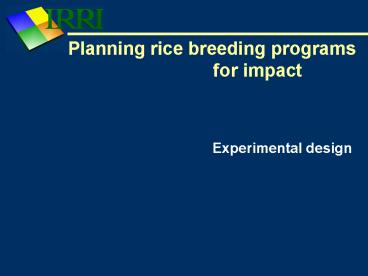Planning rice breeding programs for impact
Title:
Planning rice breeding programs for impact
Description:
Field variation can be continuous or discontinuous. Fertility or depth gradient. Old bund ... They are effective against any kind of field heterogeneity ... –
Number of Views:55
Avg rating:3.0/5.0
Title: Planning rice breeding programs for impact
1
Planning rice breeding programs
for impact
- Experimental design
2
Learning objectives
- Review the features of modern experimental
designs that allow separation of the effects of
genotype and environment - Understand the application of randomized
complete-block designs (RCBDs), alpha-lattices,
and augmented designs
3
Linear model for plot measurements
- ?For a completely randomized design (CRD)
- Where
- Yij a plot measurement
- µ the mean of all plots
- Gi the effect of the ith genotype
- ej the residual effect of the jth plot
- Gs and es sum to 0
4
The function of experimental design
- Modern experimental designs reduce the effect of
field heterogeneity (es) on estimates of
genotypic value
5
Field variation can be continuous or discontinuous
Old bund
Fertility or depth gradient
6
Field variation introduced by sprinkler
irrigation
7
Blocking versus replication
- Tools for managing field heterogeneity are
replication, randomization, and blocking - Replication with randomization make are the most
effective tools. They are effective against any
kind of field heterogeneity - Blocking (grouping of experimental lines in
small, contiguous sets of plots) is most
effective when heterogeneity is due to a smooth
gradient
8
Randomized complete-block designs
- RCBDs group all varieties in a replicate into a
single block - Block effect is removed from residual
- CRD Model Yijk µ Gi eJ
- RCBD Model Yijk µ Gi Rj ek(j)
- ?Effective when variety number is small
- ?Most effective when field gradient is gradual
9
Blocking effective against a smooth gradient in
fertility or water depth
10
(No Transcript)
11
Incomplete-block designs
- Break up large complete blocks into smaller
blocks with a fraction of the treatments - Useful when heterogeneity is great within blocks
- Often used when number of test varieties large
- Work well when field gradient is smooth
12
Can anyone briefly summarize when to use blocking
and when to use replication?
13
Alpha-lattices
- Flexible incomplete block designs that
accommodate any even number of entries, any
number of replicates - ?For example, a 42-entry trial could be divided
into 6 blocks of 7 lines per rep. - Randomization equalizes frequency of pair wise
comparisons within incomplete-blocks - Analysis removes incomplete-block effects
- Usually provides a small increase in precision
14
(No Transcript)
15
Augmented designs
- Flexible incomplete block designs that
accommodate - any even number of entries in a single replicate
- Experimental lines replicated once
- Checks occur in each block
- Checks used to estimate block effects
- Checks provide error term
- Effective, BUT much of the field is taken up with
checks
16
Effectiveness of incomplete block designs in
controlling error
- Lattices can also be analysed as RCBDs
- Effect of alpha lattice analysis on precision can
be evaluated by comparing SEM values from lattice
and RCBD analysis
17
Tests of effectiveness of alpha-lattice designs
in increasing precision
Trial set SEM for RCBD (kg/ha) SEM for alpha-lattice (kg/ha)
NE Thailand RL (WS 2001) 406 398
IRRI upland (DS 2002) 197 187
IRRI upland single rows (DS 2004) 20.3 11.7
18
Gridding to control heterogeneity in
unreplicated nurseries
- Useful for traits like seedling vigor, PA, GY
- Nursery is divided into blocks
- Selection is done within blocks only
- No repeated checks needed
19
(No Transcript)
20
When should you use
- alpha-lattices?
- augmented designs?
- gridding?
21
Conclusion
- Replication reduces influence of es
- Blocking removes part of es due to gradient
- Alpha-lattices reduce effect of smooth
within-replicate variation ?Benefits positive but
small
- Augmented designs reduce effect of smooth
within-field variation, but need many repeated
checks
- Gridding reduces effect of smooth within-field
variation, without repeated checks































